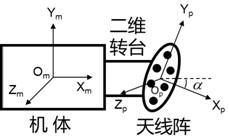Two-dimensional direction finding method and device for passive radar seeker based on spatial spectrum estimation
A technology of spatial spectrum estimation and passive radar, which is applied to direction finders using radio waves, directional multi-channel systems using radio waves, and radio wave direction/bias determination systems, etc. Direction finding, inability to obtain signal or noise subspace, wrong estimation of incoming wave direction, etc.
- Summary
- Abstract
- Description
- Claims
- Application Information
AI Technical Summary
Problems solved by technology
Method used
Image
Examples
Embodiment
[0076] The passive radar seeker antenna array is arranged in a 10-element uniform circular array, and the radius of the circular array is 15cm; four radiation source signals with the same carrier frequency, different frequency modulation and different incoming wave directions are set in the far field; the incoming wave direction is relative to the body coordinates The arrival angles of the system are (55°, 50°), (28°, 10°), (62°, -10°), (43°, -40°); the carrier frequency of the radiated linear frequency modulation signal is 1GHz; The coefficients are 5, 15, 25, 35 respectively; the signal-to-noise ratio is 20dB; the sampling rate of the direction finding system is 10GHz, and the number of data snapshots is 1000;
[0077] Step 2: Time T is set to 0.1s;
[0078] Step 3: Assume that the number N of radiation sources is 5;
[0079] Step four: T 1 Take 20ms at all times;
[0080] Step Eight: T 2 Take 70ms at all times;
[0081] Step 9: Generate the spatial spectrum of the radi...
PUM
 Login to View More
Login to View More Abstract
Description
Claims
Application Information
 Login to View More
Login to View More - Generate Ideas
- Intellectual Property
- Life Sciences
- Materials
- Tech Scout
- Unparalleled Data Quality
- Higher Quality Content
- 60% Fewer Hallucinations
Browse by: Latest US Patents, China's latest patents, Technical Efficacy Thesaurus, Application Domain, Technology Topic, Popular Technical Reports.
© 2025 PatSnap. All rights reserved.Legal|Privacy policy|Modern Slavery Act Transparency Statement|Sitemap|About US| Contact US: help@patsnap.com



